Medical scribe program strives to deliver the write fit
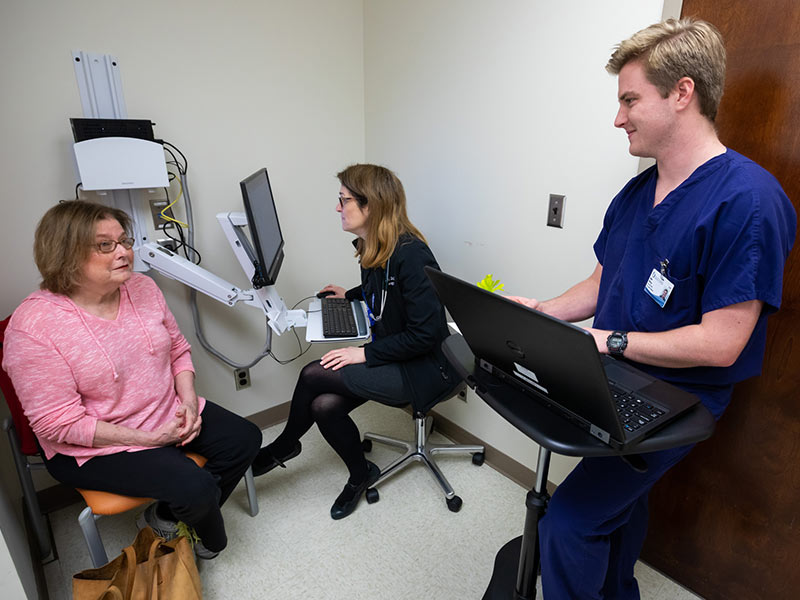
An up-and-coming education program in the School of Health Related Professions is grounded partly on the notion that a key cause of physician burnout is a keyboard.
That is, a computer keyboard – one used in the cause of electronic health records.
It’s a serious proposition considering that family physicians and other specialists often link dissatisfaction and stress with the demands of digital documentation, which have meant less time for meaningful contact with patients at work and with loved ones at home.
SHRP’s new Medical Scribe Specialist Program is designed to, among other things, supply them with experts explicitly trained to relieve those documentation burdens and recover that lost time, said Dr. Cynthia Casey, associate professor of health sciences and chair of the Health Sciences Program.
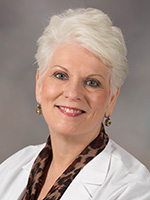
“Physicians are seeing more and more patients; documentation is so important now. Having a scribe helps with billing and coding issues and frees up the physician to be more one-on-one with patients. It increases patient satisfaction and physician satisfaction.
“Having a scribe is another layer to ensure more accurate coding. When coding is not done correctly, hospitals lose revenue.”
Accepting only students with bachelor’s degrees makes the program a first-of-its-kind in the arena of formal medical scribe training, which isn’t offered anywhere else in the state, Casey said. Right now, there are few education requirements, beyond a high school diploma, for applicants to such programs as ScribeAmerica, a company that “prefers” a college degree and computer and typing skills.
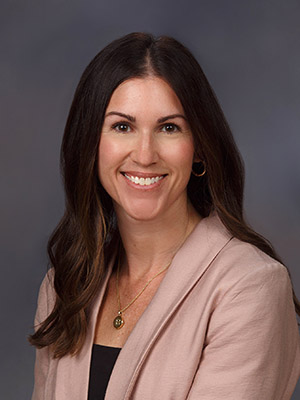
“Having a post-baccalaureate degree increases the quality of the scribes who will be working out there,” said Britney Reulet, director of the Health Sciences Program and part of program’s trio of instructors, including Casey and Dr. Pamela Jones, assistant professor of health sciences, in SHRP.
Working out there right now for Dr. Sarah Glover is her current scribe, Matt McCoy, who earned a microbiology degree at Mississippi State University.
“God bless Matt,” said Glover, professor of medicine and director of the Division of Digestive Diseases at UMMC. She has also worked scribe-less, she said.
“Yes, it was horrible. I hated it. I was always behind on my charting.”
Glover hated it enough to figure up, computer keyboard-wise, the average number of “clicks” it took to document one gastro-intestinal patient visit: “Four hundred.”
Her arithmetic was part a study she presented at the University of Florida in Gainesville, where she started a pilot medical scribe program before arriving at UMMC a year ago.
Glover’s report, which introduced the program at UF, swarmed with such tantalizing findings as these: With a scribe, clinic appointment length dropped by 13.5 minutes; between the first quarters of fiscal years 2015 and 2016, total charges billed rose by $71,439; the extra revenue for the first quarter was 536 percent higher than the salary of the scribe.
“Documentation stress decreased,” she wrote.
“The use of scribes improved the physician-patient relationship, clinical efficiency, physician productivity, bone density screening, and vaccinations for flu and pneumonia,” the report concluded.
When Glover was hired at UMMC, she had a provision for a scribe written into her contract. “Scribes catch a lot of things I might miss,” Glover said. “They improve the quality of care.” Enter McCoy.
“Matt is technologically savvy,” Glover said. “He made changes to templates and streamlined forms, all of which helped improve patient flow in our clinic.”
McCoy is apparently only one of two Medical Center employees with “scribe” officially attached to their titles, as in “Epic Scribe,” a reference to the electronic health record system in place at UMMC since 2012.
Employed by Glover, McCoy works in the clinic and lab with the physician, documenting on his laptop her spoken observations during gastrointestinal procedures or, in the exam room, a patient’s history, symptoms, etc. Later, he types up an after-visit summary and a patient plan of action, which uploads to MyChart.
“I can book more cases because I have more downtime,” Glover said. “It almost doubles my productivity.”
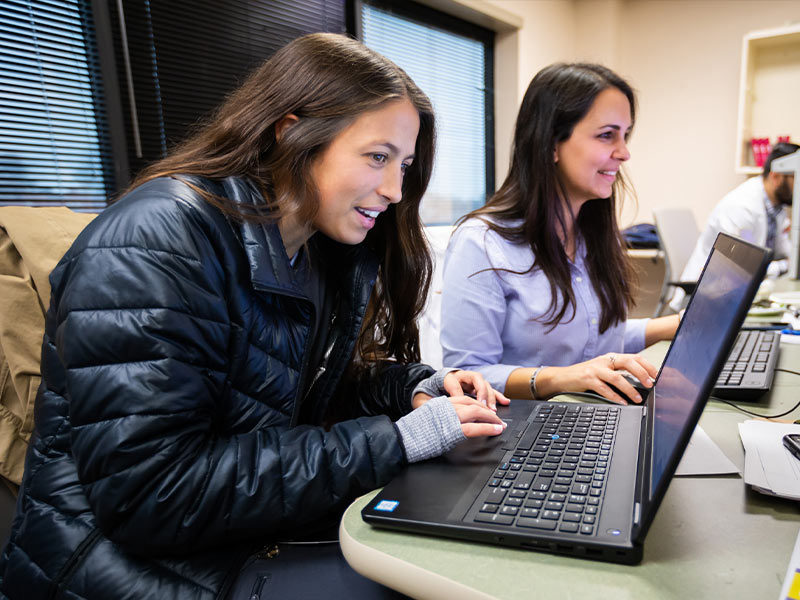
Emily E. Turner, the other medical scribe, works for Dr. Pegah Hosseini-Carroll, assistant professor of medicine in the Division of Digestive Diseases. “Having a scribe beside me allows me to focus more on the patient; I can make more eye contact,” said Carroll she reviewed patient-visit notes with Turner, an MSU graduate with an accounting degree.
“Emily saves me a lot of time. I’m faster when she is with me.” Still, Carroll is not 100 percent scribed-up: Turner splits her time among various doctors. Which may explain why Carroll spent 10 hours over the Thanksgiving holiday catching up on her charting work at home. “I was on Epic the other night until 11,” she said.
Typing fatigue has certainly taken hold among dermatologists, said Dr. Robert Brodell.
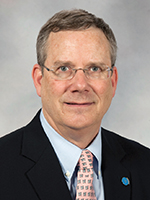
“Until about five years ago, dermatology had the happiest doctors in America,” said Brodell, chair of dermatology at UMMC. “But in a recent survey we’re now in the middle of the pack. There’s only one logical reason.” EHR, he said.
When the survey asked physicians how they have improved their work life, one replied: “Say(ing) no to unreasonable requests to function as a data-entry clerk.”
“The electronic health record has benefits,” Brodell said, “but it also makes you 30 percent less efficient.” Faculty members spend an average of 60 to 90 minutes daily on EHR after work, Brodell said.
For evidence, he cites an article for which he is listed as a co-author; its conclusion: adding assistants to perform a scribe’s tasks allows physicians to “see more patients and generate more income.”
In fact, there are other scribes at the Medical Center, although you probably shouldn’t call them that. Often, they are nurses or nurse practitioners – their real jobs – or, in many cases, students in medical school or on the way there.
Turner, for one, will begin pursuing her medical degree at UMMC this coming fall; her job as a scribe has enabled her to shadow a physician.
And the person who trained her, McCoy, trained himself on the job. He has applied for a physician assistant program he hopes to enter by early summer; as a scribe, he’s able to meet that program’s admissions requirement for clinical hours accrued.
In other words, for McCoy and Turner, their current occupation allows them to literally write their own tickets as they journey toward other careers.
As a physician, Brodell has dealt with this dynamic of transience. Last year, he hired as a scribe a prospective UMMC medical student who was then accepted to a different school and left.
“That tells me that this is not the correct way to use medical scribes in a clinic,” Brodell said.
A better way, Reulet and others say, is to put in place an education program that encourages its students to embark on medical scribe careers. SHRP’s course, which offers classes online, had five applicants by year’s end, and Casey hopes to double that, at least before the March 1 application deadline.
“In our program, students can do their clinical work at Merit Health hospitals and Baptist Medical Center, and at any site where UMMC has a clinical affiliation,” Reulet said. “We hope that will be an advantage.
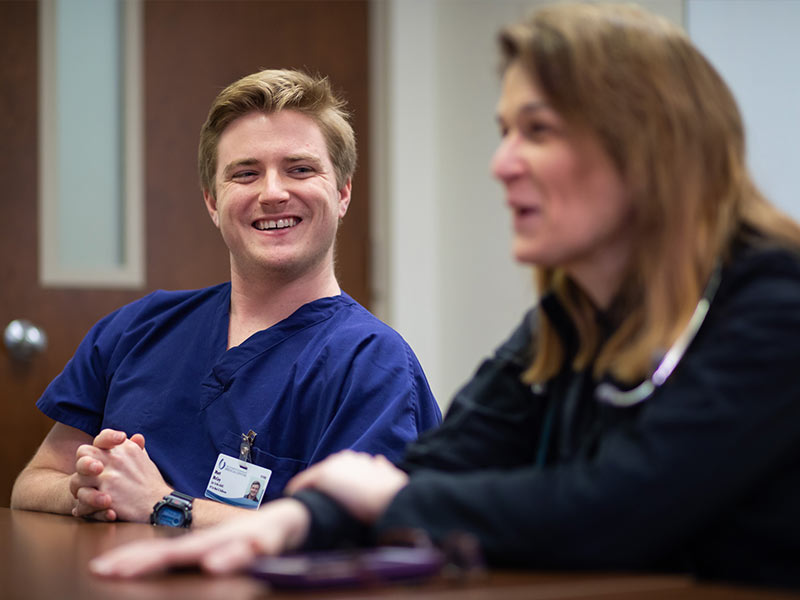
“This gives those sites students that can be molded there and hired when they graduate.”
As Glover put it: “It’s a return on your investment to have a scribe. Do you really want to pay a physician, say, $100 an hour to do charting?”
Pay for a medical scribe, nationwide, averages $12.33 an hour. Casey hopes that the new crop of specially trained scribes, with the promise of greater health records accuracy, will merit $16 to $17 an hour, she said.
Which begs the question: With higher pay, will scribes still be desirable as an investment returner?
That is one of the questions not answered yet, said Dr. Ralph Didlake, associate chancellor for academic affairs and chief academic officer.
Another: Is there a shortage of people available to do the work of a scribe?
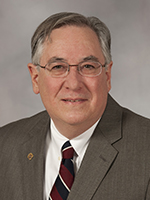
What is known: “The need for this function is out there,” Didlake said. Apparently, that means everywhere: The American College of Medical Scribe Specialists estimates 20,000 scribes were at work by the end of 2014, a number it expects to balloon to 100,000 by 2020.
At UMMC, it was Dr. Jessica Bailey, the dean of SHRP, who helped Didlake appreciate the need for a formal training course.
“She was the primary driver of the idea to start a medical scribe program,” he said, “and made a very strong case for it.” Didlake became a “strong supporter,” then remained one after he realized how the course touches all three Medical Center missions, not just education.
The health care mission is satisfied because graduates will be able to go to work immediately, including at the Medical Center.
Regarding research: “The program provides opportunities for us to test how these graduates function in a real clinical environment,” Didlake said. Those findings will be part of a pilot study, which Casey believes will take a couple of years as it measures productivity, patient and doctor satisfaction and more.
It should also answer those hanging questions about scribe shortages and investment returns, said Didlake. And for anyone wondering if an official definition for “medical scribe” is forthcoming, the answer to that is “yes – once the clinical world expresses an interest in it,” Didlake said. “We have a high confidence it will.”
There is confidence also that the creation of the Medical Scribe Specialist Program represents a new blueprint for breeding other education courses, Didlake said.
“It’s only the Medical Center’s second project developed from a workforce need.” The first, also a SHRP objective that blossomed at Bailey’s behest, was a histotechnology program, which graduated its first trainee in 2018.
“This is how we anticipate other positions will be created in the future,” Didlake said. The medical scribes training program allows a “certain segment of the workforce to advance themselves into a meaningful role in the clinic.
“It can provide a career ladder for much of our workforce.”
In the meantime, Glover is “trolling” for a potential replacement for McCoy. She knows of a drug rep’s daughter who may fill the opening, word of which spread rapidly.
“It’s a network,” Glover said. “Scribes beget scribes.” And so it was written.


